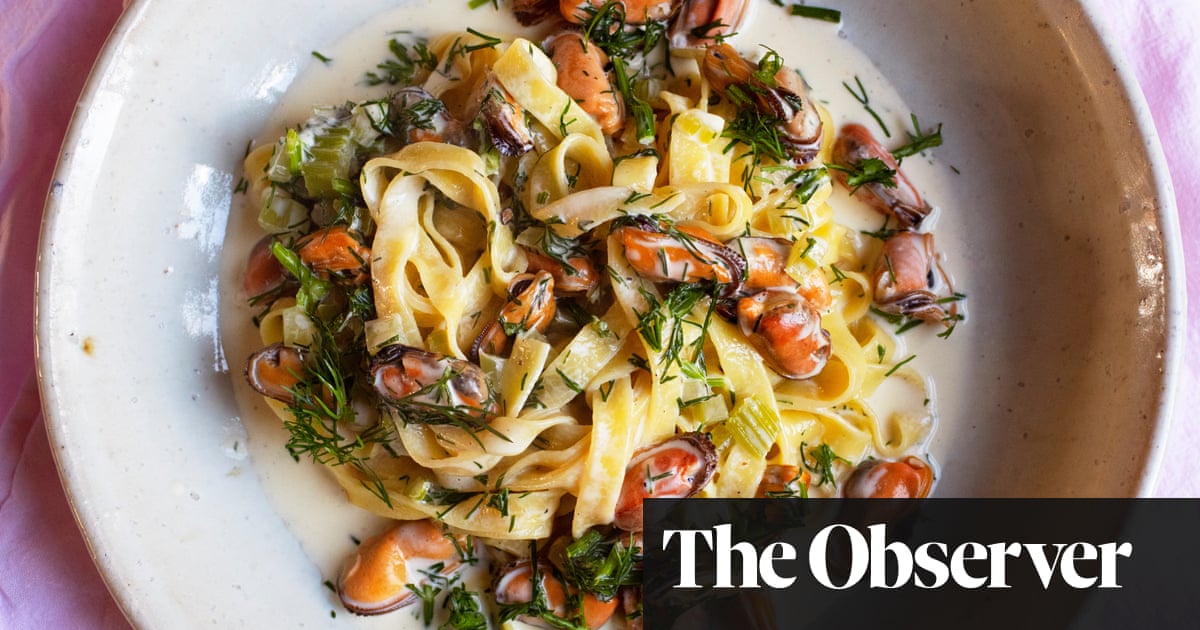Mussels, ribbons of pasta, herbs and cream is a perfect marriage for a spring lunch. I sometimes fill a puff-pastry case with such an assembly or present it in a white porcelain dish with a splodge of creamy potato in the retro style of coquille St Jacques. (And when exactly did I last see that on a menu?) The mixture of shellfish and cream is one of my favourite pasta sauces, especially when I take a few minutes to remove the mussels from their shells.
Any aniseed-scented herbs work, chervil or tarragon being good dill alternatives, but also fennel fronds. I even used celery the last time I made this, but you can also finely chop a bulb of fennel instead, letting it cook for a few minutes before you add the vermouth or white wine. You could also swap the mussels for clams, if you are the sort of person who doesn’t mind extricating the little chaps from their shells as you eat.
I prefer my Easter chocolate in the form of a crisp, thin egg, so no gooey chocolate cakes from me today. But I do like a cake for an Easter tea. A slice of something I probably wouldn’t normally make that I could offer to others. My earliest memory of cake-making involves a Swiss roll – not the neatly coiled sponge and jam arrangement one might expect, but an easy enough bake, and one open to endless interpretation. The need for something sharp and refreshing led me to fill my rolled-up cake with a mixture of lemon curd and mascarpone (using cream makes a filling too soft to roll) and firmed up my belief that this light, citrus sponge is now my go-to Easter cake.
Sweet, plump mussels, ribbons of pasta and the soft, aniseed notes of dill.
I rather enjoy teasing cooked mussels from their shells with thumb and forefinger. A delicate job, often done quickly while they are still hot, and leaving you with a pile of tender, rust-beige morsels to stir into freshly cooked pasta, pile on toast or to drop into a puddle of cream and dill. Get into the rhythm of it and you can get through a panful in 5 minutes or so.
Once shelled, the mussels are especially good tossed with flat, ribbon pasta, such as fettuccine, cream and herbs. Despite the rule about not eating mussels when there is an “r” in the month being outdated, I still tend to cook more of these little molluscs in spring and autumn.Enough for 2. Ready in 45 minutes
mussels600gcelery2 stalksgarlic2 cloveswhite vermouth or white wine125mlfettuccine150g, drieddilla 25g bunchdouble cream250ml
Scrub and scrupulously check the mussels, by which I mean checking the shells are tight and close instantly when tapped on the side of the sink. Finely dice the celery. Peel the garlic and squash each clove flat with the side of a knife blade.
Put the garlic into a deep pan, then pour in the white vermouth or wine. Place over a high heat and, as the liquid comes to the boil, add the mussels and cover tightly with a lid. Let the mussels steam for 3-4 minutes until their shells start to open. Remove the mussels from the heat, then remove each mussel from its shell. Discard the shells and strain the cooking liquor through a fine sieve.
Pour the liquor back into the clean saucepan, then place over a high heat, add the celery and a little black pepper. Lower the heat and cook for 3-5 minutes until the celery is just tender.
Meanwhile, cook the fettuccine in a pan of deep, generously salted boiling water until al dente. About 7-8 minutes from when the water returns to the boil. Finely chop the dill. Put the shelled mussels into the pan together with the chopped dill and the double cream. Warm thoroughly, then drain the pasta and toss with the sauce. Transfer to bowls and serve.
The Swiss roll has been rather neglected of late. A roll-up of soft, light cake and citrus curd, it is something to serve for dessert or tea. It goes well with green tea or a bergamot scented Earl Grey.
Serves 8. Ready in 1 hour
eggs4caster sugar150gplain flour130gbutter50g, meltedorangezest of 1lemonzestof 1
For the filling:double cream200glemon curd250g
To finish (optional):A little caster sugar, segments of orange, edible flowers
Set the oven at 180C/gas mark 4. Line a 30 x 20cm Swiss roll tin with baking parchment. Break the eggs into the bowl of a food mixer fitted with a whisk attachment. Add the sugar and beat until thick, fluffy and well risen, a good 4-5 minutes at a moderately high speed. Remove the bowl from its stand then, using a large metal spoon or rubber spatula, fold in the flour, melted butter and the orange and lemon zests. Do this tenderly but thoroughly, leaving no visible flour.
Scrape the batter into the lined Swiss roll tin, pushing it very gently into the corners. (Treating it roughly will lead to a sunken, rubbery cake.) Bake for 12-15 minutes until pale gold and lightly risen.
Place a piece of baking parchment on the work surface and sprinkle it lightly with caster sugar. Give it a couple of minutes to settle then, while still warm, turn the cake out on to the sugared paper and carefully peel away the paper the cake was baked on. Starting at one of the short sides, roll up the sugared paper and Swiss roll together and set aside to cool.
Lightly whip the cream. Unroll the cake, spread the lemon curd over the underside, then cover with the whipped cream. Carefully roll up from one of the long sides and transfer to a plate using two palette knives. Decorate with more caster sugar and, if you wish, some slices of orange and edible flowers.
Follow Nigel on Instagram@NigelSlater
